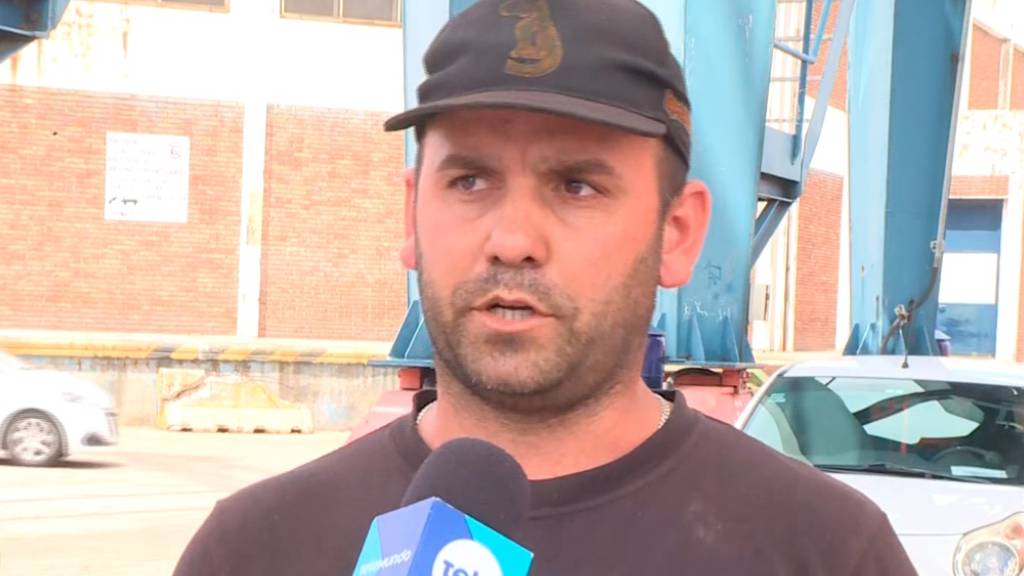Writing Argenports.com
A spectacular accident left as a balance at dawn today a floating dock, two cranes and several ships sunk in the port of Montevideo.
Fortunately, despite the large presence of workers, there were no casualties.
For reasons that are still being determined, the floating dock of the Tsakos company began to sink from the bow.
The structure had five boats on it that were under repair. Three of them and two cranes were affected.
"The collapse of the dock generated a difference in level and the cranes that are placed in each one of the bands slipped and fell," explained port captain Ricardo Della Santa, to the media of the neighboring country.
As can be seen in the videos that were broadcast on social networks, at the moment one of the cranes falls, it generates an explosion,
"As a result of that fall and explosion, the electrical power cables that feed the pumps that keep the dam afloat were cut and work is being done on that now, to start the repairs," he added, Della Santa told the newspaper El País.
"Now," he added, "the dam must be refloated and try to recover the three ships that were semi-sunken, since while they were being repaired and with part of their hull open, they had water ingress."
The other two ships, which were being repaired in the dock, which did not have an open hull, could be removed from the site, the port master said, noting that Chinese, Korean and Spanish ships were among those affected.
When falling, one of the cranes also hit "a small dredger" that was working to maintain the draft in the area of the Tsakos dam.
Meanwhile, Mario Dandraya, operations manager of the National Ports Administration (ANP), told Telemundo that “apparently the dam leaked and sank further. It affected the ships that are above the dock and the crane.”
"The dam heeled and when it sank it was uneven and the crane started to run and fell," he pointed out.
He later said that all the workers were unharmed, but they had to react quickly and jump to another boat to protect themselves.
In dialogue with the same Uruguayan media, the mechanic Adrián Valeri, belonging to the Tsakos company, owner of the dam, explained how the situation occurred and the possible causes for what happened.
"Today we arrived at about 6:00 a.m. and we found out that at about 4:15 a.m., due to problems with the dam, it sank and during that sinking there were problems with the cranes."
"The breakwater inclined so much that the cranes fell forward and collided with the iron stops, and in that moment the two cranes went into the water. When one point sank, the cranes took up a career, they slid on the tracks in the band from the dam and then they went into the water,” the mechanic recounted.
Valeri explained that "when there is a storm, lashed cranes are usually used as a precaution"; but, "in this case, that concern was not taken, therefore they left: they picked up speed and are impossible to stop." "A crane fell on each side," he explained, adding that "the dam is now resting on the mud, it hit bottom."
A structure of many years
Asked about the possible causes of what happened, the worker said: “This has happened over the years, it is an old dam. I think it was brought in after World War II. He must be over 100 years old."
“In each maneuver sometimes you have to put submersible pumps because sometimes a tank cracks or there are valve problems. Normally it usually happens that some maneuver has to be carried out, but something like this never happened, but it was to be prevented due to a maintenance issue, ”he added.

This is what the Tsakos dam looks like after the collapse that affected cranes and ships in the port of Montevideo. Photo: El País.
Now, Valeri explained, the work will be to bring to life all the affected infrastructure to, from that point, evaluate the repair tasks. “Now we have to work on the affected ships, see if the dock floats, see if there was a problem with the tanks. Here there is work for about a week, working at least 12 hours on the road. Or longer. You have to first put it afloat and see that there is no danger, ”he said. “It may take a week to get everything out there. And then a month to repair everything, ”he added.
“It didn't end in tragedy, but now the tragedy is there, because colleagues will be left without work. We are around 90 effective, and with occasional contracts we sometimes reach 200 employees. But those eventual ones already know that today their work is over,” said the mechanic about the situation of the workers.
During the episode, meanwhile, no one was affected, but that was due to the quick reaction of those who were on the scene. "Luckily there were no injuries. For the company there were three or four colleagues, who do night guards, in addition to firefighters and a person in charge. Most people tried to save themselves. Those in the boats were able to jump onto a ship that was afloat. And from that ship, when they saw l













